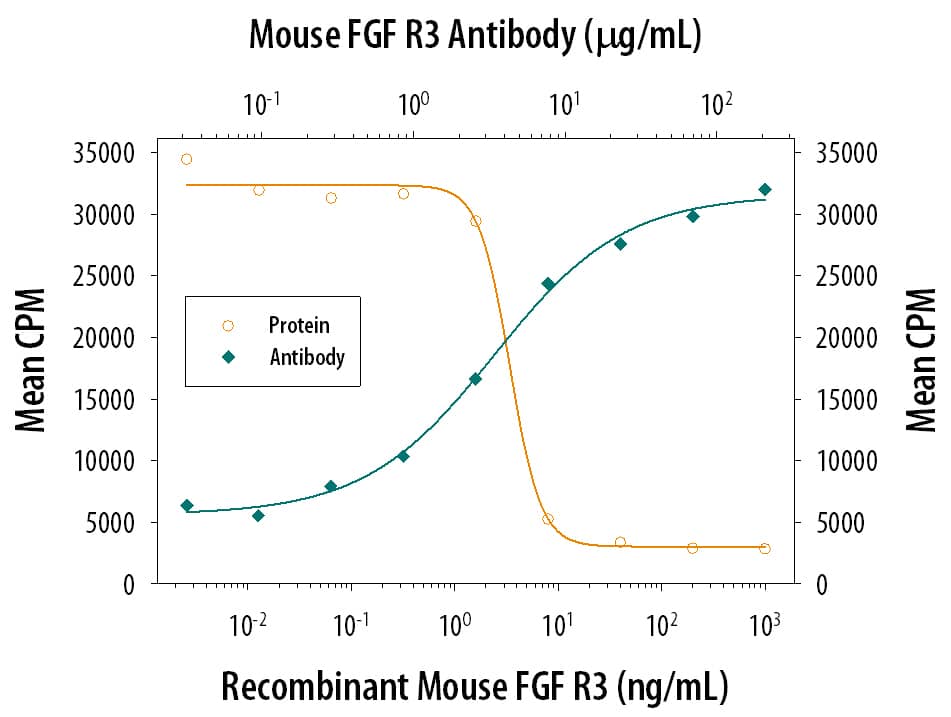Mouse FGFR3 Antibody Summary
Glu21-Tyr369 (Asn310Ile, Ala354 del) (predicted)
Accession # NP_001156689
Applications
Please Note: Optimal dilutions should be determined by each laboratory for each application. General Protocols are available in the Technical Information section on our website.
Scientific Data
 View Larger
View Larger
FGF R3 Inhibition of FGF acidic-dependent Cell Proliferation and Neutral-ization by Mouse FGF R3 Antibody. Recombinant Mouse FGF R3 (IIIc) Fc Chimera (Catalog # 710-MF) inhibits Recom-binant Human FGF acidic (Catalog # 232-FA) induced proliferation in the NR6R-3T3 mouse fibroblast cell line in a dose-dependent manner (orange line). Inhibition of Recom-binant Human FGF acidic (0.3 ng/mL) activity elicited by Recom-binant Mouse FGF R3 (IIIc) Fc Chimera (12 ng/mL) is neutralized (green line) by increasing concentrations of Rat Anti-Mouse FGF R3 Mono-clonal Antibody (Catalog # MAB710). The ND50 is typically 3-12 µg/mL in the presence of heparin (10 µg/mL).
Reconstitution Calculator
Preparation and Storage
- 12 months from date of receipt, -20 to -70 °C as supplied.
- 1 month, 2 to 8 °C under sterile conditions after reconstitution.
- 6 months, -20 to -70 °C under sterile conditions after reconstitution.
Background: FGFR3
Fibroblast growth factors (FGFs) comprise a family of at least eighteen structurally related proteins that are involved in a multitude of physiological and pathological cellular processes, including cell growth, differentiation, angiogenesis, wound healing and tumorgenesis. The biological activities of the FGFs are mediated by a family of type I transmembrane tyrosine kinases which undergo dimerization and autophosphorylation after ligand binding. Four distinct genes encoding closely related FGF receptors, FGF R1‑4, are known. All four genes for FGF Rs encode proteins with an N‑terminal signal peptide, three immunoglobulin (Ig)‑like domains, an acid‑box region containing a run of acidic residues between the IgI and IgII domains, a transmembrane domain and the split tyrosine‑kinase domain. Multiple forms of FGF R1‑3 are generated by alternative splicing of the mRNAs. A frequent splicing event involving FGF R1 and 2 results in receptors containing all three Ig domains, referred to as the alpha isoform, or only IgII and IgIII, referred to as the beta isoform. Only the alpha isoform has been identified for FGF R3 and FGF R4. Additional splicing events for FGF R1‑3, involving the C‑terminal half of the IgIII domain encoded by two mutually exclusive alternative exons, generate FGF receptors with alternative IgIII domains (IIIb and IIIc). A IIIa isoform which is a secreted FGF binding protein containing only the N‑terminal half of the IgIII domain plus some intron sequences has also been reported for FGF R1. Mutations in FGF R1‑3 have been found in patients with birth defects involving craniosynostosis. The complex patterns of expression of these receptors as well as the specificity of their interactions with the various FGF ligand family members are being investigated.
- Galzie, Z. et al. (1997) Biochem. Cell Biol. 75:669.
- Burke, D. et al. (1998) Trends Biochem. Sci. 23:59.
Product Datasheets
Citations for Mouse FGFR3 Antibody
R&D Systems personnel manually curate a database that contains references using R&D Systems products. The data collected includes not only links to publications in PubMed, but also provides information about sample types, species, and experimental conditions.
4
Citations: Showing 1 - 4
Filter your results:
Filter by:
-
Responses of Epibranchial Placodes to Disruptions of the FGF and BMP Signaling Pathways in Embryonic Mice
Authors: Stefan Washausen, Wolfgang Knabe
Frontiers in Cell and Developmental Biology
-
Neuronal mTORC1 is required for maintaining the nonreactive state of astrocytes
Authors: Yue Zhang
J. Biol. Chem, 2016-11-28;0(0):.
Species: Mouse
Sample Types: In Vivo
Applications: Neutralization -
Fibroblast Growth Factor 23 (FGF23) and Alpha-Klotho Stimulate Osteoblastic MC3T3.E1 Cell Proliferation and Inhibit Mineralization
Authors: V. Shalhoub, S. C. Ward, B. Sun, J. Stevens, L. Renshaw, N. Hawkins et al.
Calcified Tissue International
-
Prox1 promotes lineage-specific expression of fibroblast growth factor (FGF) receptor-3 in lymphatic endothelium: a role for FGF signaling in lymphangiogenesis.
Authors: Shin JW, Min M, Larrieu-Lahargue F, Canron X, Kunstfeld R, Nguyen L, Henderson JE, Bikfalvi A, Detmar M, Hong YK
Mol. Biol. Cell, 2005-11-16;17(2):576-84.
Species: Mouse
Sample Types: Whole Tissue
Applications: IHC-Fr
FAQs
No product specific FAQs exist for this product, however you may
View all Antibody FAQsReviews for Mouse FGFR3 Antibody
There are currently no reviews for this product. Be the first to review Mouse FGFR3 Antibody and earn rewards!
Have you used Mouse FGFR3 Antibody?
Submit a review and receive an Amazon gift card.
$25/€18/£15/$25CAN/¥75 Yuan/¥2500 Yen for a review with an image
$10/€7/£6/$10 CAD/¥70 Yuan/¥1110 Yen for a review without an image




